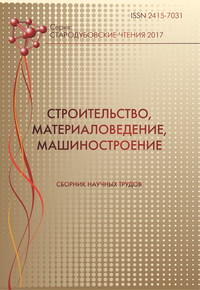Structure and mechanical properties of welded joints of 14khgn2mdafb steels at the laser - welding
Keywords:
high-strength steel, the laser-welding, welded joints, mechanical properties, metal structure, phase composition, structural parameters, hardening.Abstract
Annotation. Purpose. Nowadays, in the manufacture of welded structures of a responsible design, progressive laser welding technologies, which allow obtaining high-quality welded joints by using high welding speeds in the cooling speed range of 30...100°C/s, have been obtained. This significantly increases (more than doubled compared with arc welding) the productivity of the welding process and provides an improvement in the mechanical properties of welded joints. The purpose of this work was to study the features of phase and structural changes in the metal of welded joints of high-strength steel obtained by laser welding and to estimate the effect of laser welding technological parameters on the formed structure and mechanical properties of welded joints. Techniques. The investigations were carried out on welded joints of high-strength 14KhGN2MDAFB steel. Welded joints were obtained at different speeds (18...50 m/h) of laser welding using a technological CO2-laser with a wavelength of 10.6 μm (focal spot diameter 0.4 mm) without the use of filler materials. Structural-phase and concentration changes in chemical elements in the weld metal and in the heataffected zone were studied by methods of optical metallography (microscopes Versamet-2, Neophot-32) and analytical scanning electron microscopy (scanning electron microscope SEM-515 from PHILIPS, The Netherlands). Results. Based on obtained experimental data on different structural levels, analytical estimates were made that show the influence of specific structural parameters (phase composition, grain and subgrain structures) on the mechanical properties of welded joints depending on the laser welding regimes. Scientific novelty. Technological regimes of laser welding of high-strength 14KhGN2MDAFB steel have been determined, which provide the optimal structure and phase composition and thus high indicators of mechanical properties of welded joints. Practical significance. The obtained results showed the prospects of using technological modes of laser welding, which provide the necessary complex of mechanical properties of welded joints by forming the most favorable structure of the weld metal and the heat affected zone.References
Katayama S. Handbook of laser welding technologies. Cambridge: Woodhead Publishing Limited, 2013, 677 p. Available at: http://dx.doi.org/10.1533/9780857098771.
Cao X., Wanjara P., Huang J., Munro C. and Nolting A. Hybrid fiber laser–Arc welding of thick section high strength low alloy steel. Materials & Design. 2011, vol. 32, no. 6, pp. 3399-3413. Available at: http://dx.doi.org/10.1016/j.matdes.2011.02.002.
Markovits T., Takács J. Edge welding of laminated steel structure by pulsed Nd:YAG laser. Physics Procedia. 2010, vol. 5, part B, pp. 47-52. Available at: http://dx.doi.org/10.1016/j.phpro.2010.08.028.
Shelyagin V. D., Krivtsun I. V., Borisov Yu. S., Haskin V.Yu., Nabok T. N., Siora A. V., Bernatskiy A. V., Voynarovich S. G., Kislitsa A. N. and Nedey T. N. Lazerno-dugovyie i lazerno-plazmennyie tehnologii svarki i naneseniya pokryitiy [Laser-arc and laser-plasma welding and coating technologies]. Avtomaticheskaya svarka [Automatic welding]. 2005, no. 8, pp. 49-54. Available at: http://www.scopus.com/inward/record.url?eid=2-s2.0-29144499023&partnerID=MN8TOARS (in Russian).
Markashova L.I., Grigorenko G.M., Poznjakov V.D., Berdnikova E.N. i dr. Vlijanie termicheskih ciklov svarki i vneshnego nagruzhenija na strukturno-fazovye izmenenija i svojstva soedinenij stali 17Kh2M [Influence of welding thermal cycles and external loading on the structural and phase transformations and properties of the joints of 17Kh2M steel]. Avtomaticheskaja svarka, 2009, no. 7, pp. 21-29. (in Russian).
Markashova L.I., Poznjakov V.D., Alekseenko T.A., Berdnikova E.N. i dr. Vlijanie legirovanija shvov na strukturu i svojstva svarnyh soedinenij stali 17Kh2M [Effect of weld doping on the structure and properties of welded joints of 17Kh2M steel]. Avtomaticheskaja svarka, 2011, no. 4, pp. 7-15. (in Russian).
Markashova L.I., Poznjakov V.D., Berdnikova E.N., Alekseenko T.A i dr. Struktura i ekspluatacionnye svoystva svarnyh soedineniy metallov i splavov [Structure and service propeties of welding joints of metals and alloys] // Zbornik trudov VIII Mezhdunarodnoy konferentsii Matematicheskoe modelirovanie I informacionnye tehnologii v svarce I rodstvennyh procesah (1923 sentabra 2016 g., Kiev). –Kiev-2016, pp.54-63.
Published
Issue
Section
License
Редакція Видання категорично засуджує прояви плагіату в статтях та вживає всіх можливих заходів для його недопущення. Плагіат розглядається як форма порушення авторських прав і наукової етики.
При виявлені у статті більш ніж 25% запозиченого тексту без відповідних посилань та використання лапок, стаття кваліфікується як така, що містить плагіат. У цьому випадку стаття більше не розглядається редакцією, а автор отримує перше попередження.
Автори, в статтях яких повторно виявлено плагіат, не зможуть публікуватися в усіх журналах Видавництва ДВНЗ «Придніпровська державна академія будівництва та архітектури».
Автори, які публікуються у цьому журналі, погоджуються з наступними умовами:
- Автори залишають за собою право на авторство своєї роботи та передають журналу право першої публікації цієї роботи на умовах ліцензії Creative Commons Attribution License, котра дозволяє іншим особам вільно розповсюджувати опубліковану роботу з обов'язковим посиланням на авторів оригінальної роботи та першу публікацію роботи у цьому журналі.
- Автори мають право укладати самостійні додаткові угоди щодо неексклюзивного розповсюдження роботи у тому вигляді, в якому вона була опублікована цим журналом (наприклад, розміщувати роботу в електронному сховищі установи або публікувати у складі монографії), за умови збереження посилання на першу публікацію роботи у цьому журналі.
- Політика журналу дозволяє і заохочує розміщення авторами в мережі Інтернет (наприклад, у сховищах установ або на особистих веб-сайтах) рукопису роботи, як до подання цього рукопису до редакції, так і під час його редакційного опрацювання, оскільки це сприяє виникненню продуктивної наукової дискусії та позитивно позначається на оперативності та динаміці цитування опублікованої роботи (див. The Effect of Open Access).

